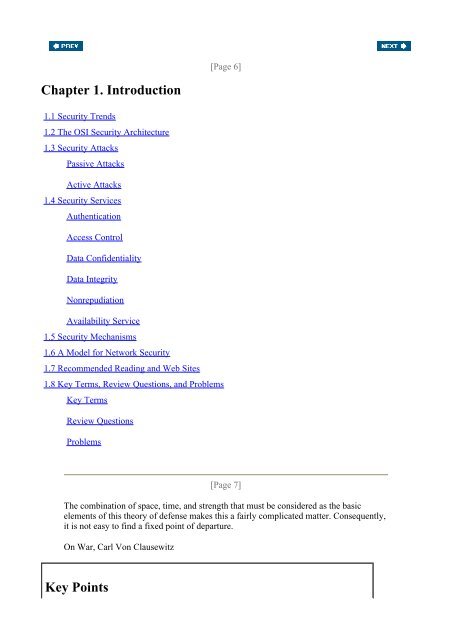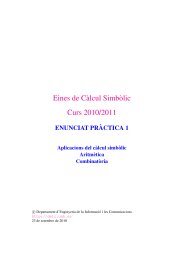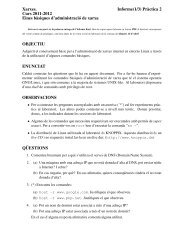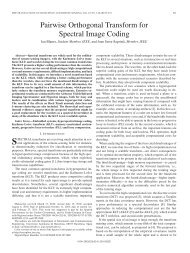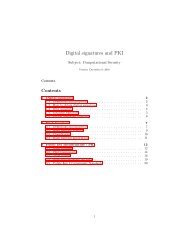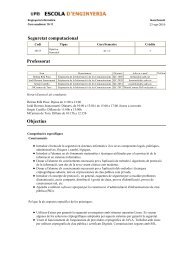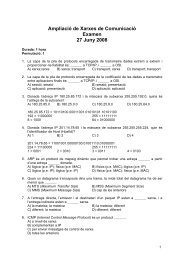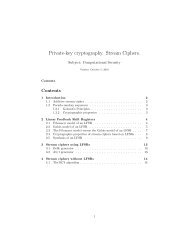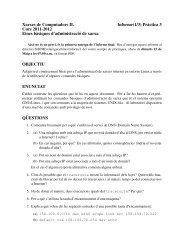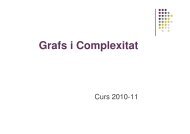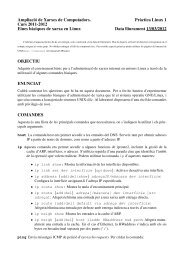Chapter 1. Introduction Key Points - dEIC
Chapter 1. Introduction Key Points - dEIC
Chapter 1. Introduction Key Points - dEIC
Create successful ePaper yourself
Turn your PDF publications into a flip-book with our unique Google optimized e-Paper software.
[Page 6]<br />
<strong>Chapter</strong> <strong>1.</strong> <strong>Introduction</strong><br />
<strong>1.</strong>1 Security Trends<br />
<strong>1.</strong>2 The OSI Security Architecture<br />
<strong>1.</strong>3 Security Attacks<br />
Passive Attacks<br />
Active Attacks<br />
<strong>1.</strong>4 Security Services<br />
Authentication<br />
Access Control<br />
Data Confidentiality<br />
Data Integrity<br />
Nonrepudiation<br />
Availability Service<br />
<strong>1.</strong>5 Security Mechanisms<br />
<strong>1.</strong>6 A Model for Network Security<br />
<strong>1.</strong>7 Recommended Reading and Web Sites<br />
<strong>1.</strong>8 <strong>Key</strong> Terms, Review Questions, and Problems<br />
<strong>Key</strong> Terms<br />
Review Questions<br />
Problems<br />
[Page 7]<br />
The combination of space, time, and strength that must be considered as the basic<br />
elements of this theory of defense makes this a fairly complicated matter. Consequently,<br />
it is not easy to find a fixed point of departure.<br />
On War, Carl Von Clausewitz<br />
<strong>Key</strong> <strong>Points</strong>
• The OSI (open systems interconnection) security architecture provides a<br />
systematic framework for defining security attacks, mechanisms, and services.<br />
• Security attacks are classified as either passive attacks, which include<br />
unauthorized reading of a message of file and traffic analysis; and active attacks,<br />
such as modification of messages or files, and denial of service.<br />
• A security mechanism is any process (or a device incorporating such a process)<br />
that is designed to detect, prevent, or recover from a security attack. Examples of<br />
mechanisms are encryption algorithms, digital signatures, and authentication<br />
protocols.<br />
• Security services include authentication, access control, data confidentiality, data<br />
integrity, nonrepudiation, and availability.<br />
The requirements of information security within an organization have undergone two major changes<br />
in the last several decades. Before the widespread use of data processing equipment, the security of<br />
information felt to be valuable to an organization was provided primarily by physical and<br />
administrative means. An example of the former is the use of rugged filing cabinets with a<br />
combination lock for storing sensitive documents. An example of the latter is personnel screening<br />
procedures used during the hiring process.<br />
With the introduction of the computer, the need for automated tools for protecting files and other<br />
information stored on the computer became evident. This is especially the case for a shared system,<br />
such as a time-sharing system, and the need is even more acute for systems that can be accessed over<br />
a public telephone network, data network, or the Internet. The generic name for the collection of<br />
tools designed to protect data and to thwart hackers is computer security.<br />
The second major change that affected security is the introduction of distributed systems and the use<br />
of networks and communications facilities for carrying data between terminal user and computer and<br />
between computer and computer. Network security measures are needed to protect data during their<br />
transmission. In fact, the term network security is somewhat misleading, because virtually all<br />
business, government, and academic organizations interconnect their data processing equipment with<br />
a collection of interconnected networks. Such a collection is often referred to as an internet, [1] and<br />
the term internet security is used.<br />
[1]<br />
We use the term internet, with a lowercase "i," to refer to any interconnected<br />
collection of networks. A corporate intranet is an example of an internet. The Internet<br />
with a capital "I" may be one of the facilities used by an organization to construct its<br />
internet.<br />
[Page 8]<br />
There are no clear boundaries between these two forms of security. For example, one of the most<br />
publicized types of attack on information systems is the computer virus. A virus may be introduced<br />
into a system physically when it arrives on a diskette or optical disk and is subsequently loaded onto<br />
a computer. Viruses may also arrive over an internet. In either case, once the virus is resident on a<br />
computer system, internal computer security tools are needed to detect and recover from the virus.<br />
This book focuses on internet security, which consists of measures to deter, prevent, detect, and<br />
correct security violations that involve the transmission of information. That is a broad statement that
covers a host of possibilities. To give you a feel for the areas covered in this book, consider the<br />
following examples of security violations:<br />
<strong>1.</strong> User A transmits a file to user B. The file contains sensitive information (e.g., payroll records)<br />
that is to be protected from disclosure. User C, who is not authorized to read the file, is able to<br />
monitor the transmission and capture a copy of the file during its transmission.<br />
2. A network manager, D, transmits a message to a computer, E, under its management. The<br />
message instructs computer E to update an authorization file to include the identities of a<br />
number of new users who are to be given access to that computer. User F intercepts the<br />
message, alters its contents to add or delete entries, and then forwards the message to E, which<br />
accepts the message as coming from manager D and updates its authorization file accordingly.<br />
3. Rather than intercept a message, user F constructs its own message with the desired entries and<br />
transmits that message to E as if it had come from manager D. Computer E accepts the<br />
message as coming from manager D and updates its authorization file accordingly.<br />
4. An employee is fired without warning. The personnel manager sends a message to a server<br />
system to invalidate the employee's account. When the invalidation is accomplished, the server<br />
is to post a notice to the employee's file as confirmation of the action. The employee is able to<br />
intercept the message and delay it long enough to make a final access to the server to retrieve<br />
sensitive information. The message is then forwarded, the action taken, and the confirmation<br />
posted. The employee's action may go unnoticed for some considerable time.<br />
5. A message is sent from a customer to a stockbroker with instructions for various transactions.<br />
Subsequently, the investments lose value and the customer denies sending the message.<br />
Although this list by no means exhausts the possible types of security violations, it illustrates the<br />
range of concerns of network security.<br />
[Page 9]<br />
Internetwork security is both fascinating and complex. Some of the reasons follow:<br />
<strong>1.</strong> Security involving communications and networks is not as simple as it might first appear to<br />
the novice. The requirements seem to be straightforward; indeed, most of the major<br />
requirements for security services can be given self-explanatory one-word labels:<br />
confidentiality, authentication, nonrepudiation, integrity. But the mechanisms used to meet<br />
those requirements can be quite complex, and understanding them may involve rather subtle<br />
reasoning.<br />
2. In developing a particular security mechanism or algorithm, one must always consider<br />
potential attacks on those security features. In many cases, successful attacks are designed by<br />
looking at the problem in a completely different way, therefore exploiting an unexpected<br />
weakness in the mechanism.<br />
3. Because of point 2, the procedures used to provide particular services are often<br />
counterintuitive: It is not obvious from the statement of a particular requirement that such<br />
elaborate measures are needed. It is only when the various countermeasures are considered<br />
that the measures used make sense.<br />
4. Having designed various security mechanisms, it is necessary to decide where to use them.<br />
This is true both in terms of physical placement (e.g., at what points in a network are certain
security mechanisms needed) and in a logical sense [e.g., at what layer or layers of an<br />
architecture such as TCP/IP (Transmission Control Protocol/Internet Protocol) should<br />
mechanisms be placed].<br />
5. Security mechanisms usually involve more than a particular algorithm or protocol. They<br />
usually also require that participants be in possession of some secret information (e.g., an<br />
encryption key), which raises questions about the creation, distribution, and protection of that<br />
secret information. There is also a reliance on communications protocols whose behavior may<br />
complicate the task of developing the security mechanism. For example, if the proper<br />
functioning of the security mechanism requires setting time limits on the transit time of a<br />
message from sender to receiver, then any protocol or network that introduces variable,<br />
unpredictable delays may render such time limits meaningless.<br />
Thus, there is much to consider. This chapter provides a general overview of the subject matter that<br />
structures the material in the remainder of the book. We begin with a general discussion of network<br />
security services and mechanisms and of the types of attacks they are designed for. Then we develop<br />
a general overall model within which the security services and mechanisms can be viewed.<br />
<strong>1.</strong><strong>1.</strong> Security Trends<br />
[Page 9 (continued)]<br />
In 1994, the Internet Architecture Board (IAB) issued a report entitled "Security in the Internet<br />
Architecture" (RFC 1636). The report stated the general consensus that the Internet needs more and<br />
better security, and it identified key areas for security mechanisms. Among these were the need to<br />
secure the network infrastructure from unauthorized monitoring and control of network traffic and<br />
the need to secure end-user-to-end-user traffic using authentication and encryption mechanisms.<br />
[Page 10]<br />
These concerns are fully justified. As confirmation, consider the trends reported by the Computer<br />
Emergency Response Team (CERT) Coordination Center (CERT/CC). Figure <strong>1.</strong>1a shows the trend<br />
in Internet-related vulnerabilities reported to CERT over a 10-year period. These include security<br />
weaknesses in the operating systems of attached computers (e.g., Windows, Linux) as well as<br />
vulnerabilities in Internet routers and other network devices. Figure <strong>1.</strong>1b shows the number of<br />
security-related incidents reported to CERT. These include denial of service attacks; IP spoofing, in<br />
which intruders create packets with false IP addresses and exploit applications that use<br />
authentication based on IP; and various forms of eavesdropping and packet sniffing, in which<br />
attackers read transmitted information, including logon information and database contents.<br />
[Page 11]<br />
Figure <strong>1.</strong><strong>1.</strong> CERT Statistics<br />
(This item is displayed on page 10 in the print version)<br />
[View full size image]
Over time, the attacks on the Internet and Internet-attached systems have grown more sophisticated<br />
while the amount of skill and knowledge required to mount an attack has declined (Figure <strong>1.</strong>2).<br />
Attacks have become more automated and can cause greater amounts of damage.<br />
Figure <strong>1.</strong>2. Trends in Attack Sophistication and Intruder Knowledge<br />
[View full size image]
This increase in attacks coincides with an increased use of the Internet and with increases in the<br />
complexity of protocols, applications, and the Internet itself. Critical infrastructures increasingly rely<br />
on the Internet for operations. Individual users rely on the security of the Internet, email, the Web,<br />
and Web-based applications to a greater extent than ever. Thus, a wide range of technologies and<br />
tools are needed to counter the growing threat. At a basic level, cryptographic algorithms for<br />
confidentiality and authentication assume greater importance. As well, designers need to focus on<br />
Internet-based protocols and the vulnerabilities of attached operating systems and applications. This<br />
book surveys all of these technical areas.<br />
<strong>1.</strong>2. The OSI Security Architecture<br />
[Page 12]<br />
To assess effectively the security needs of an organization and to evaluate and choose various<br />
security products and policies, the manager responsible for security needs some systematic way of<br />
defining the requirements for security and characterizing the approaches to satisfying those<br />
requirements. This is difficult enough in a centralized data processing environment; with the use of<br />
local and wide area networks, the problems are compounded.<br />
ITU-T [2] Recommendation X.800, Security Architecture for OSI, defines such a systematic<br />
approach. [3] The OSI security architecture is useful to managers as a way of organizing the task of<br />
providing security. Furthermore, because this architecture was developed as an international<br />
standard, computer and communications vendors have developed security features for their products<br />
and services that relate to this structured definition of services and mechanisms.<br />
[2]<br />
The International Telecommunication Union (ITU) Telecommunication<br />
Standardization Sector (ITU-T) is a United Nationssponsored agency that develops<br />
standards, called Recommendations, relating to telecommunications and to open
systems interconnection (OSI).<br />
[3]<br />
The OSI security architecture was developed in the context of the OSI protocol<br />
architecture, which is described in Appendix H. However, for our purposes in this<br />
chapter, an understanding of the OSI protocol architecture is not required.<br />
For our purposes, the OSI security architecture provides a useful, if abstract, overview of many of<br />
the concepts that this book deals with. The OSI security architecture focuses on security attacks,<br />
mechanisms, and services. These can be defined briefly as follows:<br />
• Security attack: Any action that compromises the security of information owned by an<br />
organization.<br />
• Security mechanism: A process (or a device incorporating such a process) that is designed to<br />
detect, prevent, or recover from a security attack.<br />
• Security service: A processing or communication service that enhances the security of the data<br />
processing systems and the information transfers of an organization. The services are intended<br />
to counter security attacks, and they make use of one or more security mechanisms to provide<br />
the service.<br />
In the literature, the terms threat and attack are commonly used to mean more or less the same thing.<br />
Table <strong>1.</strong>1 provides definitions taken from RFC 2828, Internet Security Glossary.<br />
Threat<br />
Table <strong>1.</strong><strong>1.</strong> Threats and Attacks (RFC 2828)<br />
A potential for violation of security, which exists when there is a<br />
circumstance, capability, action, or event that could breach security and cause<br />
harm. That is, a threat is a possible danger that might exploit a vulnerability.<br />
Attack<br />
An assault on system security that derives from an intelligent threat; that is,<br />
an intelligent act that is a deliberate attempt (especially in the sense of a<br />
method or technique) to evade security services and violate the security<br />
policy of a system.<br />
<strong>1.</strong>3. Security Attacks<br />
[Page 13]<br />
A useful means of classifying security attacks, used both in X.800 and RFC 2828, is in terms of<br />
passive attacks and active attacks. A passive attack attempts to learn or make use of information<br />
from the system but does not affect system resources. An active attack attempts to alter system<br />
resources or affect their operation.<br />
Passive Attacks
Passive attacks are in the nature of eavesdropping on, or monitoring of, transmissions. The goal of<br />
the opponent is to obtain information that is being transmitted. Two types of passive attacks are<br />
release of message contents and traffic analysis.<br />
The release of message contents is easily understood (Figure <strong>1.</strong>3a). A telephone conversation, an<br />
electronic mail message, and a transferred file may contain sensitive or confidential information. We<br />
would like to prevent an opponent from learning the contents of these transmissions.<br />
Figure <strong>1.</strong>3. Passive Attacks<br />
(This item is displayed on page 14 in the print version)<br />
[View full size image]<br />
A second type of passive attack, traffic analysis, is subtler (Figure <strong>1.</strong>3b). Suppose that we had a way<br />
of masking the contents of messages or other information traffic so that opponents, even if they<br />
captured the message, could not extract the information from the message. The common technique<br />
for masking contents is encryption. If we had encryption protection in place, an opponent might still<br />
be able to observe the pattern of these messages. The opponent could determine the location and<br />
identity of communicating hosts and could observe the frequency and length of messages being<br />
exchanged. This information might be useful in guessing the nature of the communication that was<br />
taking place.
Passive attacks are very difficult to detect because they do not involve any alteration of the data.<br />
Typically, the message traffic is sent and received in an apparently normal fashion and neither the<br />
sender nor receiver is aware that a third party has read the messages or observed the traffic pattern.<br />
However, it is feasible to prevent the success of these attacks, usually by means of encryption. Thus,<br />
the emphasis in dealing with passive attacks is on prevention rather than detection.<br />
Active Attacks<br />
Active attacks involve some modification of the data stream or the creation of a false stream and can<br />
be subdivided into four categories: masquerade, replay, modification of messages, and denial of<br />
service.<br />
A masquerade takes place when one entity pretends to be a different entity (Figure <strong>1.</strong>4a). A<br />
masquerade attack usually includes one of the other forms of active attack. For example,<br />
authentication sequences can be captured and replayed after a valid authentication sequence has<br />
taken place, thus enabling an authorized entity with few privileges to obtain extra privileges by<br />
impersonating an entity that has those privileges.<br />
Figure <strong>1.</strong>4. Active Attacks<br />
(This item is displayed on pages 15 - 16 in the print version)<br />
[View full size image]
Replay involves the passive capture of a data unit and its subsequent retransmission to produce an<br />
unauthorized effect (Figure <strong>1.</strong>4b).<br />
[Page 14]<br />
Modification of messages simply means that some portion of a legitimate message is altered, or that<br />
messages are delayed or reordered, to produce an unauthorized effect (Figure <strong>1.</strong>4c). For example, a<br />
message meaning "Allow John Smith to read confidential file accounts" is modified to mean "Allow<br />
Fred Brown to read confidential file accounts."<br />
The denial of service prevents or inhibits the normal use or management of communications<br />
facilities (Figure <strong>1.</strong>4d). This attack may have a specific target; for example, an entity may suppress<br />
all messages directed to a particular destination (e.g., the security audit service). Another form of<br />
service denial is the disruption of an entire network, either by disabling the network or by<br />
overloading it with messages so as to degrade performance.<br />
[Page 15]<br />
Active attacks present the opposite characteristics of passive attacks. Whereas passive attacks are<br />
difficult to detect, measures are available to prevent their success. On the other hand, it is quite<br />
difficult to prevent active attacks absolutely, because of the wide variety of potential physical,<br />
software, and network vulnerabilities. Instead, the goal is to detect active attacks and to recover from<br />
any disruption or delays caused by them. If the detection has a deterrent effect, it may also contribute<br />
to prevention.<br />
<strong>1.</strong>4. Security Services<br />
[Page 16]<br />
X.800 defines a security service as a service provided by a protocol layer of communicating open<br />
systems, which ensures adequate security of the systems or of data transfers. Perhaps a clearer<br />
definition is found in RFC 2828, which provides the following definition: a processing or<br />
communication service that is provided by a system to give a specific kind of protection to system<br />
resources; security services implement security policies and are implemented by security<br />
mechanisms.<br />
[Page 17]<br />
X.800 divides these services into five categories and fourteen specific services (Table <strong>1.</strong>2). We look<br />
at each category in turn. [4]<br />
[4]<br />
There is no universal agreement about many of the terms used in the security<br />
literature. For example, the term integrity is sometimes used to refer to all aspects of<br />
information security. The term authentication is sometimes used to refer both to<br />
verification of identity and to the various functions listed under integrity in this chapter.<br />
Our usage here agrees with both X.800 and RFC 2828.
Table <strong>1.</strong>2. Security Services (X.800)<br />
AUTHENTICATION<br />
The assurance that the communicating entity is the one that it<br />
claims to be.<br />
Peer Entity Authentication<br />
Used in association with a logical connection to provide confidence in the<br />
identity of the entities connected.<br />
Data Origin Authentication<br />
In a connectionless transfer, provides assurance that the source of received<br />
data is as claimed.<br />
ACCESS CONTROL<br />
The prevention of unauthorized use of a resource (i.e., this<br />
service controls who can have access to a resource, under what<br />
conditions access can occur, and what those accessing the<br />
resource are allowed to do).<br />
DATA CONFIDENTIALITY<br />
The protection of data from unauthorized disclosure.<br />
Connection Confidentiality<br />
The protection of all user data on a connection.<br />
Connectionless Confidentiality<br />
The protection of all user data in a single data block<br />
Selective-Field Confidentiality<br />
The confidentiality of selected fields within the user data on a connection or<br />
in a single data block.<br />
Traffic Flow Confidentiality<br />
The protection of the information that might be derived from observation of<br />
traffic flows.<br />
DATA INTEGRITY<br />
The assurance that data received are exactly as sent by an<br />
authorized entity (i.e., contain no modification, insertion,<br />
deletion, or replay).<br />
Connection Integrity with Recovery<br />
Provides for the integrity of all user data on a connection and detects any<br />
modification, insertion, deletion, or replay of any data within an entire data<br />
sequence, with recovery attempted.<br />
Connection Integrity without Recovery<br />
As above, but provides only detection without recovery.<br />
Selective-Field Connection Integrity<br />
Provides for the integrity of selected fields within the user data of a data
lock transferred over a connection and takes the form of determination of<br />
whether the selected fields have been modified, inserted, deleted, or replayed.<br />
Connectionless Integrity<br />
Provides for the integrity of a single connectionless data block and may take<br />
the form of detection of data modification. Additionally, a limited form of<br />
replay detection may be provided.<br />
Selective-Field Connectionless Integrity<br />
Provides for the integrity of selected fields within a single connectionless<br />
data block; takes the form of determination of whether the selected fields<br />
have been modified.<br />
NONREPUDIATION<br />
Provides protection against denial by one of the entities involved<br />
in a communication of having participated in all or part of the<br />
communication.<br />
Nonrepudiation, Origin<br />
Proof that the message was sent by the specified party.<br />
Nonrepudiation, Destination<br />
Proof that the message was received by the specified party.<br />
Authentication<br />
[Page 18]<br />
The authentication service is concerned with assuring that a communication is authentic. In the case<br />
of a single message, such as a warning or alarm signal, the function of the authentication service is to<br />
assure the recipient that the message is from the source that it claims to be from. In the case of an<br />
ongoing interaction, such as the connection of a terminal to a host, two aspects are involved. First, at<br />
the time of connection initiation, the service assures that the two entities are authentic, that is, that<br />
each is the entity that it claims to be. Second, the service must assure that the connection is not<br />
interfered with in such a way that a third party can masquerade as one of the two legitimate parties<br />
for the purposes of unauthorized transmission or reception.<br />
Two specific authentication services are defined in X.800:<br />
• Peer entity authentication: Provides for the corroboration of the identity of a peer entity in an<br />
association. It is provided for use at the establishment of, or at times during the data transfer<br />
phase of, a connection. It attempts to provide confidence that an entity is not performing either<br />
a masquerade or an unauthorized replay of a previous connection.<br />
• Data origin authentication: Provides for the corroboration of the source of a data unit. It does<br />
not provide protection against the duplication or modification of data units. This type of<br />
service supports applications like electronic mail where there are no prior interactions between<br />
the communicating entities.<br />
Access Control
In the context of network security, access control is the ability to limit and control the access to host<br />
systems and applications via communications links. To achieve this, each entity trying to gain access<br />
must first be identified, or authenticated, so that access rights can be tailored to the individual.<br />
Data Confidentiality<br />
Confidentiality is the protection of transmitted data from passive attacks. With respect to the content<br />
of a data transmission, several levels of protection can be identified. The broadest service protects all<br />
user data transmitted between two users over a period of time. For example, when a TCP connection<br />
is set up between two systems, this broad protection prevents the release of any user data transmitted<br />
over the TCP connection. Narrower forms of this service can also be defined, including the<br />
protection of a single message or even specific fields within a message. These refinements are less<br />
useful than the broad approach and may even be more complex and expensive to implement.<br />
The other aspect of confidentiality is the protection of traffic flow from analysis. This requires that<br />
an attacker not be able to observe the source and destination, frequency, length, or other<br />
characteristics of the traffic on a communications facility.<br />
Data Integrity<br />
As with confidentiality, integrity can apply to a stream of messages, a single message, or selected<br />
fields within a message. Again, the most useful and straightforward approach is total stream<br />
protection.<br />
[Page 19]<br />
A connection-oriented integrity service, one that deals with a stream of messages, assures that<br />
messages are received as sent, with no duplication, insertion, modification, reordering, or replays.<br />
The destruction of data is also covered under this service. Thus, the connection-oriented integrity<br />
service addresses both message stream modification and denial of service. On the other hand, a<br />
connectionless integrity service, one that deals with individual messages without regard to any larger<br />
context, generally provides protection against message modification only.<br />
We can make a distinction between the service with and without recovery. Because the integrity<br />
service relates to active attacks, we are concerned with detection rather than prevention. If a<br />
violation of integrity is detected, then the service may simply report this violation, and some other<br />
portion of software or human intervention is required to recover from the violation. Alternatively,<br />
there are mechanisms available to recover from the loss of integrity of data, as we will review<br />
subsequently. The incorporation of automated recovery mechanisms is, in general, the more<br />
attractive alternative.<br />
Nonrepudiation<br />
Nonrepudiation prevents either sender or receiver from denying a transmitted message. Thus, when a<br />
message is sent, the receiver can prove that the alleged sender in fact sent the message. Similarly,<br />
when a message is received, the sender can prove that the alleged receiver in fact received the<br />
message.<br />
Availability Service<br />
Both X.800 and RFC 2828 define availability to be the property of a system or a system resource<br />
being accessible and usable upon demand by an authorized system entity, according to performance<br />
specifications for the system (i.e., a system is available if it provides services according to the system
design whenever users request them). A variety of attacks can result in the loss of or reduction in<br />
availability. Some of these attacks are amenable to automated countermeasures, such as<br />
authentication and encryption, whereas others require some sort of physical action to prevent or<br />
recover from loss of availability of elements of a distributed system.<br />
X.800 treats availability as a property to be associated with various security services. However, it<br />
makes sense to call out specifically an availability service. An availability service is one that protects<br />
a system to ensure its availability. This service addresses the security concerns raised by denial-ofservice<br />
attacks. It depends on proper management and control of system resources and thus depends<br />
on access control service and other security services.<br />
<strong>1.</strong>5. Security Mechanisms<br />
[Page 19 (continued)]<br />
Table <strong>1.</strong>3 lists the security mechanisms defined in X.800. As can be seen the mechanisms are divided<br />
implemented in a specific protocol layer and those that are not specific to any particular protocol laye<br />
service. These mechanisms will be covered in the appropriate places in the book and so we do not ela<br />
to comment on the definition of encipherment. X.800 distinguishes between reversible encipherment m<br />
irreversible encipherment mechanisms. A reversible encipherment mechanism is simply an encryption<br />
allows data to be encrypted and subsequently decrypted. Irreversible encipherment mechanisms inclu<br />
and message authentication codes, which are used in digital signature and message authentication app<br />
[Page 20]<br />
Table <strong>1.</strong>3. Security Mechanisms (X.800)<br />
SPECIFIC SECURITY MECHANISMS<br />
May be incorporated into the appropriate protocol layer in order<br />
to provide some of the OSI security services.<br />
Encipherment<br />
The use of mathematical algorithms to transform data into a form that is not<br />
readily intelligible. The transformation and subsequent recovery of the data<br />
depend on an algorithm and zero or more encryption keys.<br />
Digital Signature<br />
Data appended to, or a cryptographic transformation of, a data unit that<br />
allows a recipient of the data unit to prove the source and integrity of the data<br />
unit and protect against forgery (e.g., by the recipient).<br />
Access Control<br />
A variety of mechanisms that enforce access rights to resources.<br />
Data Integrity<br />
A variety of mechanisms used to assure the integrity of a data unit or stream<br />
of data units.<br />
Authentication Exchange
A mechanism intended to ensure the identity of an entity by means of<br />
information exchange.<br />
Traffic Padding<br />
The insertion of bits into gaps in a data stream to frustrate traffic analysis<br />
attempts.<br />
Routing Control<br />
Enables selection of particular physically secure routes for certain data and<br />
allows routing changes, especially when a breach of security is suspected.<br />
Notarization<br />
The use of a trusted third party to assure certain properties of a data<br />
exchange.<br />
PERVASIVE SECURITY MECHANISMS<br />
Mechanisms that are not specific to any particular OSI security<br />
service or protocol layer.<br />
Trusted Functionality<br />
That which is perceived to be correct with respect to some criteria (e.g., as<br />
established by a security policy).<br />
Security Label<br />
The marking bound to a resource (which may be a data unit) that names or<br />
designates the security attributes of that resource.<br />
Event Detection<br />
Detection of security-relevant events.<br />
Security Audit Trail<br />
Data collected and potentially used to facilitate a security audit, which is an<br />
independent review and examination of system records and activities.<br />
Security Recovery<br />
Deals with requests from mechanisms, such as event handling and<br />
management functions, and takes recovery actions.<br />
Table <strong>1.</strong>4, based on one in X.800, indicates the relationship between security services and security me<br />
[Page 21]<br />
Table <strong>1.</strong>4. Relationship between Security Services and Mechanisms<br />
Service<br />
Peer entity<br />
authentication<br />
Encipherment<br />
Digital<br />
Signature<br />
Access<br />
Control<br />
Mechanism<br />
Data<br />
Integrity<br />
Authentication<br />
Exchange<br />
Y Y Y<br />
Traffic<br />
Padding<br />
Routi<br />
Contr
Data origin<br />
authentication<br />
Access control<br />
Y<br />
Y<br />
Y<br />
Confidentiality Y Y<br />
Traffic flow<br />
confidentiality<br />
Y Y Y<br />
Data integrity Y Y Y<br />
Nonrepudiation Y Y<br />
Availability Y Y<br />
<strong>1.</strong>6. A Model for Network Security<br />
[Page 22]<br />
A model for much of what we will be discussing is captured, in very general terms, in Figure <strong>1.</strong>5. A<br />
message is to be transferred from one party to another across some sort of internet. The two parties,<br />
who are the principals in this transaction, must cooperate for the exchange to take place. A logical<br />
information channel is established by defining a route through the internet from source to destination<br />
and by the cooperative use of communication protocols (e.g., TCP/IP) by the two principals.<br />
Figure <strong>1.</strong>5. Model for Network Security<br />
[View full size image]<br />
Security aspects come into play when it is necessary or desirable to protect the information<br />
transmission from an opponent who may present a threat to confidentiality, authenticity, and so on.<br />
All the techniques for providing security have two components:
• A security-related transformation on the information to be sent. Examples include the<br />
encryption of the message, which scrambles the message so that it is unreadable by the<br />
opponent, and the addition of a code based on the contents of the message, which can be used<br />
to verify the identity of the sender<br />
• Some secret information shared by the two principals and, it is hoped, unknown to the<br />
opponent. An example is an encryption key used in conjunction with the transformation to<br />
scramble the message before transmission and unscramble it on reception. [5]<br />
[5]<br />
Part Two discusses a form of encryption, known as public-key encryption, in<br />
which only one of the two principals needs to have the secret information.<br />
[Page 23]<br />
A trusted third party may be needed to achieve secure transmission. For example, a third party may<br />
be responsible for distributing the secret information to the two principals while keeping it from any<br />
opponent. Or a third party may be needed to arbitrate disputes between the two principals concerning<br />
the authenticity of a message transmission.<br />
This general model shows that there are four basic tasks in designing a particular security service:<br />
<strong>1.</strong> Design an algorithm for performing the security-related transformation. The algorithm should<br />
be such that an opponent cannot defeat its purpose.<br />
2. Generate the secret information to be used with the algorithm.<br />
3. Develop methods for the distribution and sharing of the secret information.<br />
4. Specify a protocol to be used by the two principals that makes use of the security algorithm<br />
and the secret information to achieve a particular security service.<br />
Parts One through Three of this book concentrates on the types of security mechanisms and services<br />
that fit into the model shown in Figure <strong>1.</strong>5. However, there are other security-related situations of<br />
interest that do not neatly fit this model but that are considered in this book. A general model of<br />
these other situations is illustrated by Figure <strong>1.</strong>6, which reflects a concern for protecting an<br />
information system from unwanted access. Most readers are familiar with the concerns caused by the<br />
existence of hackers, who attempt to penetrate systems that can be accessed over a network. The<br />
hacker can be someone who, with no malign intent, simply gets satisfaction from breaking and<br />
entering a computer system. Or, the intruder can be a disgruntled employee who wishes to do<br />
damage, or a criminal who seeks to exploit computer assets for financial gain (e.g., obtaining credit<br />
card numbers or performing illegal money transfers).<br />
Figure <strong>1.</strong>6. Network Access Security Model<br />
[View full size image]
Another type of unwanted access is the placement in a computer system of logic that exploits<br />
vulnerabilities in the system and that can affect application programs as well as utility programs,<br />
such as editors and compilers. Programs can present two kinds of threats:<br />
• Information access threats intercept or modify data on behalf of users who should not have<br />
access to that data.<br />
• Service threats exploit service flaws in computers to inhibit use by legitimate users.<br />
[Page 24]<br />
Viruses and worms are two examples of software attacks. Such attacks can be introduced into a<br />
system by means of a disk that contains the unwanted logic concealed in otherwise useful software.<br />
They can also be inserted into a system across a network; this latter mechanism is of more concern in<br />
network security.<br />
The security mechanisms needed to cope with unwanted access fall into two broad categories (see<br />
Figure <strong>1.</strong>6). The first category might be termed a gatekeeper function. It includes password-based<br />
login procedures that are designed to deny access to all but authorized users and screening logic that<br />
is designed to detect and reject worms, viruses, and other similar attacks. Once either an unwanted<br />
user or unwanted software gains access, the second line of defense consists of a variety of internal<br />
controls that monitor activity and analyze stored information in an attempt to detect the presence of<br />
unwanted intruders. These issues are explored in Part Four.<br />
[Page 24 (continued)]<br />
<strong>1.</strong>7. Recommended Reading and Web Sites<br />
[PFLE02] provides a good introduction to both computer and network security. Two other excellent<br />
surveys are [PIEP03] and [BISH05]. [BISH03] covers much the same ground as [BISH05] but with<br />
more mathematical detail and rigor. [SCHN00] is valuable reading for any practitioner in the field of<br />
computer or network security: it discusses the limitations of technology, and cryptography in<br />
particular, in providing security, and the need to consider the hardware, the software implementation,<br />
the networks, and the people involved in providing and attacking security.<br />
BISH03 Bishop, M. Computer Security: Art and Science.<br />
Boston: Addison-Wesley, 2003.
BISH05 Bishop, M. <strong>Introduction</strong> to Computer Security. Boston:<br />
Addison-Wesley, 2005.<br />
PFLE02 Pfleeger, C. Security in Computing. Upper Saddle<br />
River, NJ: Prentice Hall, 2002.<br />
PIEP03 Pieprzyk, J.; Hardjono, T.; and Seberry, J. Fundamentals<br />
of Computer Security. New York: Springer-Verlag, 2003.<br />
SCHN00 Schneier, B. Secrets and Lies: Digital Security in a<br />
Networked World. New York: Wiley 2000.<br />
Recommended Web Sites<br />
The following Web sites [6] are of general interest related to cryptography and network security:<br />
[6]<br />
Because URLs sometimes change, they are not included. For all of the Web sites<br />
listed in this and subsequent chapters, the appropriate link is at this book's Web site at<br />
williamstallings.com/Crypto/Crypto4e.html.<br />
• COAST: Comprehensive set of links related to cryptography and network security.<br />
• IETF Security Area: Material related to Internet security standardization efforts.<br />
• Computer and Network Security Reference Index: A good index to vendor and commercial<br />
products, FAQs, newsgroup archives, papers, and other Web sites.<br />
[Page 25]<br />
• The Cryptography FAQ: Lengthy and worthwhile FAQ covering all aspects of cryptography.<br />
• Tom Dunigan's Security Page: An excellent list of pointers to cryptography and network<br />
security Web sites.<br />
• Helgar Lipma's Cryptology Pointers: Another excellent list of pointers to cryptography and<br />
network security Web sites.<br />
• IEEE Technical Committee on Security and Privacy: Copies of their newsletter, information<br />
on IEEE-related activities.<br />
• Computer Security Resource Center: Maintained by the National Institute of Standards and<br />
Technology (NIST); contains a broad range of information on security threats, technology, and<br />
standards.<br />
• Security Focus: A wide variety of security information, with an emphasis on vendor products<br />
and end-user concerns.<br />
• SANS Institute: Similar to Security Focus. Extensive collection of white papers.
[Page 25 (continued)]<br />
<strong>1.</strong>8. <strong>Key</strong> Terms, Review Questions, and Problems<br />
<strong>Key</strong> Terms<br />
access control<br />
active threat<br />
authentication<br />
authenticity<br />
availability<br />
data confidentiality<br />
data integrity<br />
denial of service<br />
encryption<br />
integrity<br />
intruder<br />
masquerade<br />
nonrepudiation<br />
OSI security architecture<br />
passive threat<br />
replay<br />
security attacks<br />
security mechanisms<br />
security services<br />
traffic analysis<br />
Review Questions
<strong>1.</strong>1 What is the OSI security architecture?<br />
<strong>1.</strong>2 What is the difference between passive and active security threats?<br />
<strong>1.</strong>3 List and briefly define categories of passive and active security attacks.<br />
<strong>1.</strong>4 List and briefly define categories of security services.<br />
<strong>1.</strong>5 List and briefly define categories of security mechanisms.<br />
Problems<br />
<strong>1.</strong>1 Draw a matrix similar to Table <strong>1.</strong>4 that shows the relationship between security<br />
services and attacks.<br />
<strong>1.</strong>2 Draw a matrix similar to Table <strong>1.</strong>4 that shows the relationship between security<br />
mechanisms and attacks.


